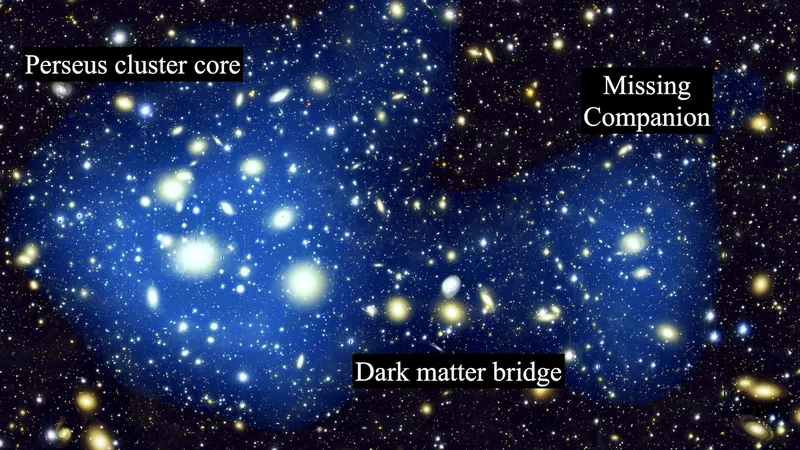
Astronomers Unveil Massive Cosmic 'Bridge' That Could Crack Open Galactic Mysteries!
2025-04-29
Author: John Tan
In a groundbreaking discovery, astronomers have unveiled an astounding cosmic 'bridge' that may finally clarify the chaotic history behind the Perseus galaxy cluster, traditionally thought to be stable and calm.
The Perseus Cluster: An Unseen Collision?
The Perseus galaxy cluster, a colossal assemblage of galaxies stretching across a staggering 11.6 million light-years—about 100 times the width of our own Milky Way—has long been considered one of the universe's most massive celestial structures. Located a mere 250 million light-years from Earth, this gigantic cluster is currently racing away from us at an astonishing speed of over 3,300 miles per second due to the universe's ongoing expansion.
What Does 'Relaxed' Really Mean?
Astronomers typically label galaxy clusters as 'relaxed' when they exhibit stability, indicating they haven’t recently collided with other clusters. For years, the Perseus cluster epitomized this relaxed state, with its hot gas uniformly circulating and a faint radio glow indicating a serene cosmic environment. However, a closer inspection revealed a startling asymmetry in its shape, suggesting an underlying disturbance.
Cold Fronts Hinting at a Collision!
In a jaw-dropping turn of events, astronomers identified 'cold fronts' within the cluster in 2012—massive regions forming from collisions between galaxy clusters. This marked a significant clue that indicated a past cataclysmic collision. Yet, a crucial question lingered: where was the other galaxy cluster involved in this cosmic smash-up?
Discovering the 'Smoking Gun' in Cosmic History!
Now, researchers from the U.S. and South Korea believe they've pinpointed the elusive interloper using a technique called weak gravitational lensing. This method uncovers how massive objects distort light from background galaxies, revealing hidden cosmic structures.
A Deep-Dive into Gravitational Lensing!
Gravitational lensing, a phenomenon predicted by Albert Einstein over a century ago, happens when massive celestial bodies warp space-time around them, bending light and magnifying distant sources. In this latest study, astronomers harnessed the power of the Subaru Telescope in Hawaii to analyze the subtle distortions of light from galaxies behind the Perseus cluster.
A New Cosmic Connection Revealed!
The research unveiled a vast subcluster halo around galaxy NGC 1264, nestled within the outskirts of the Perseus cluster. This region of both visible and dark matter is linked to the main cluster by a stunning 'mass bridge' stretching over 1.4 million light-years and boasting nearly 100 times the mass of the Milky Way.
A Turbulent Cosmic Dance!
Simulations indicated that this bridge is clear evidence of gravitational interactions between the two clusters, an insight that resonates with the peculiar lopsided shape observed. The team's models suggest that this cosmic tango has been unfolding for approximately 7.5 billion years.
Implications for the Universe and Beyond!
This groundbreaking discovery not only sheds light on the formation and evolution of galaxy clusters but also underscores the effectiveness of weak gravitational lensing in uncovering the universe's hidden secrets. As researchers explore this extraordinary cluster, the implications could transform our understanding of the cosmos, paving the way for future explorations of even more elusive cosmic mergers.
As the Perseus cluster continues to fascinate scientists, its ongoing study promises to unlock more cosmic mysteries, offering a window into the complex life of galaxies.


 Brasil (PT)
Brasil (PT)
 Canada (EN)
Canada (EN)
 Chile (ES)
Chile (ES)
 Česko (CS)
Česko (CS)
 대한민국 (KO)
대한민국 (KO)
 España (ES)
España (ES)
 France (FR)
France (FR)
 Hong Kong (EN)
Hong Kong (EN)
 Italia (IT)
Italia (IT)
 日本 (JA)
日本 (JA)
 Magyarország (HU)
Magyarország (HU)
 Norge (NO)
Norge (NO)
 Polska (PL)
Polska (PL)
 Schweiz (DE)
Schweiz (DE)
 Singapore (EN)
Singapore (EN)
 Sverige (SV)
Sverige (SV)
 Suomi (FI)
Suomi (FI)
 Türkiye (TR)
Türkiye (TR)
 الإمارات العربية المتحدة (AR)
الإمارات العربية المتحدة (AR)